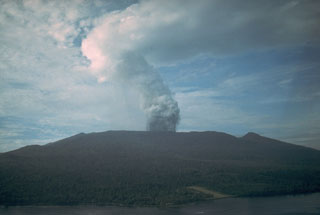Report on Karkar (Papua New Guinea) — January 1980
Scientific Event Alert Network Bulletin, vol. 5, no. 1 (January 1980)
Managing Editor: David Squires.
Karkar (Papua New Guinea) Possible weak ash emissions
Please cite this report as:
Global Volcanism Program, 1980. Report on Karkar (Papua New Guinea) (Squires, D., ed.). Scientific Event Alert Network Bulletin, 5:1. Smithsonian Institution. https://doi.org/10.5479/si.GVP.SEAN198001-251030
Karkar
Papua New Guinea
4.647°S, 145.976°E; summit elev. 1839 m
All times are local (unless otherwise noted)
"Observations from the Kinim Observatory at the NW coast of Karkar indicated that no strong explosive activity occurred during January. Unconfirmed reports were received of weak ash emissions on 7 and 17 January.
"During a summit inspection 28 January, the lake was of a uniform light grey/brown colour, and there was no sign of the peninsula reported in November and December. Convection was occurring in the lake. Fumarolic activity on Bagiai Cone and on the SE part of the caldera floor was extensive but fumaroles were not strong and vapour was emitted under low pressure.
"Gravity observations on 27 and 28 January indicated increased values at stations on the flanks and summit, a reversal of previous trends. Tilt observations for the same period are incomplete. The new gravity trend may be interpreted as deflation, and an indication that the eruption is over. However, a further round of measurements will be required to confirm this."
Geological Summary. Karkar is a 19 x 25 km forest-covered island that is truncated by two nested summit calderas. The 5.5 km outer caldera was formed during one or more eruptions, the last of which occurred 9,000 years ago. The steep-walled 300-m-deep, 3.2 km diameter, inner caldera was formed sometime between 1,500 and 800 years ago. Cones are present on the N and S flanks of this basaltic-to-andesitic volcano; a linear array of small cones extends from the northern rim of the outer caldera nearly to the coast. Recorded eruptions date back to 1643 from Bagiai, a pyroclastic cone constructed within the inner caldera, the floor of which is covered by young, mostly unvegetated andesitic lava flows.
Information Contacts: B. Scott and C. McKee, RVO.

